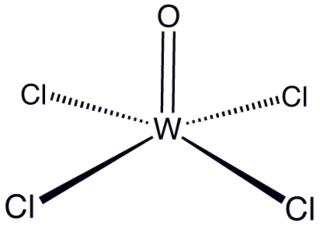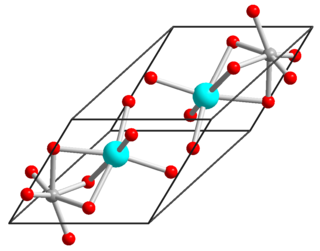
Potassium bicarbonate (IUPAC name: potassium hydrogencarbonate, also known as potassium acid carbonate) is the inorganic compound with the chemical formula KHCO3. It is a white solid.
Propylene, also known as propene, is an unsaturated organic compound with the chemical formula CH3CH=CH2. It has one double bond, and is the second simplest member of the alkene class of hydrocarbons. It is a colorless gas with a faint petroleum-like odor.

Fumaric acid is an organic compound with the formula HO2CCH=CHCO2H. A white solid, fumaric acid occurs widely in nature. It has a fruit-like taste and has been used as a food additive. Its E number is E297. The salts and esters are known as fumarates. Fumarate can also refer to the C
4H
2O2−
4 ion (in solution). Fumaric acid is the trans isomer of butenedioic acid, while maleic acid is the cis isomer.

Methylene diphenyl diisocyanate (MDI) is an aromatic diisocyanate. Three isomers are common, varying by the positions of the isocyanate groups around the rings: 2,2′-MDI, 2,4′-MDI, and 4,4′-MDI. The 4,4′ isomer is most widely used, and is also known as 4,4′-diphenylmethane diisocyanate. This isomer is also known as Pure MDI. MDI reacts with polyols in the manufacture of polyurethane. It is the most produced diisocyanate, accounting for 61.3% of the global market in the year 2000.

Rhenium(VII) oxide is the inorganic compound with the formula Re2O7. This yellowish solid is the anhydride of HOReO3. Perrhenic acid, Re2O7·2H2O, is closely related to Re2O7. Re2O7 is the raw material for all rhenium compounds, being the volatile fraction obtained upon roasting the host ore.

Tungsten(VI) oxytetrachloride is the inorganic compound with the formula WOCl4. This diamagnetic solid is used to prepare other complexes of tungsten. The yellow-green compound is soluble in nonpolar solvents but it reacts with alcohols and water and forms adducts with Lewis bases.
Zirconium (IV) hydroxide, often called hydrous zirconia is an ill-defined material or family of materials variously described as ZrO2·nH2O and Zr(OH)4·nH2O. All are white solids with low solubility in water. These materials are widely employed in the preparation of solid acid catalysts.

Palladium(II) bis(acetylacetonate) is a compound with formula Pd(C5H7O2)2. This yellow solid is the most common palladium complex of acetylacetonate. This compound is commercially available and used as a catalyst precursor in organic synthesis. The molecule is relatively planar with idealized D2h symmetry.

Cefetamet is a cephalosporin antibiotic.

Tripotassium phosphate, also called tribasic potassium phosphate is a water-soluble salt with the chemical formula K3PO4.(H2O)x (x = 0, 3, 7, 9). Tripotassium phosphate is basic.
In chemistry, methanetetracarboxylate is a tetravalent anion with formula C
5O4−
8 or C(COO−)4. It has four carboxylate groups attached to a central carbon atom; so it has the same carbon backbone as neopentane. It is an oxocarbon anion, that is, consists only of carbon and oxygen.

Nickel(II) titanate is an inorganic compound with the chemical formula NiTiO3 nickel(II) titanate, also known as nickel titanium oxide, is a coordination compound between nickel(II), titanium(IV) and oxide ions. It has the appearance of a yellow powder. There are several methods of synthesis for nickel(II) titanate. The first method involves nickel(II) titanate's melting temperature of over 500 °C at which its precursor decomposes to give nickel(II) titanate as a residue. Nickel(II) titanate has been used as a catalyst for toluene oxidation. The second method involved using enthalpy and entropy on the reaction to synthesize nickel(II) titanate through its phase transition.

Dibutyltin dilaurate is an organotin compound with the formula (CH310CO2)2Sn( 3CH3)2. It is a colorless viscous and oily liquid. It is used as a catalyst.

Methyldichlorophosphine (alternatively known as dichloro(methyl)phosphane and methyl phosphonous dichloride) is an organophosphorus compound with the chemical formula CH3PCl2. It is a colorless, corrosive, flammable, and highly reactive liquid with a pungent odor.

Rubidium acetate is a rubidium compound that is the result of dissolving rubidium metal, rubidium carbonate, or rubidium hydroxide in acetic acid. It is soluble in water like other acetates.
2-Ethylhexyl glycidyl ether is a liquid organic molecule with formula C11H22O2 an industrial chemical used to reduce the viscosity of epoxy resins. These are then used in adhesives, sealants, and paints or coatings. It has the CAS Registry Number of 2461-15-6. It has the IUPAC name of 2-(2-ethylhexoxymethyl)oxirane. It also finds use in other polymer based applications.
Neopentyl glycol diglycidyl ether (NPGDGE) is an organic chemical in the glycidyl ether family. It is aliphatic and a colorless liquid. It has the formula C11H20O4 and the CAS registry number of 17557-23-2. It has two oxirane groups per molecule. Its principle use is in modifying epoxy resins.

C12-C14 alcohol glycidyl ether (AGE) is an organic chemical in the glycidyl ether family. It is a mixture of mainly 12 and 14 carbon chain alcohols, also called fatty alcohols that have been glycidated. It is an industrial chemical used as a surfactant but primarily for epoxy resin viscosity reduction. It has the CAS number 68609-97-2 but the IUPAC name is more complex as it is a mixture and is 2-(dodecoxymethyl)oxirane;2-(tetradecoxymethyl)oxirane;2-(tridecoxymethyl)oxirane. Other names include dodecyl and tetradecyl glycidyl ethers and alkyl (C12-C14) glycidyl ether.

Ytterbium(III) acetate is an inorganic salt of ytterbium and acetic acid, with a chemical formula of Yb(CH3COO)3. It has colorless crystals that are soluble in water and can form hydrates.

Diglycidyl aniline is an aromatic organic chemical in the glycidyl compound family. It is used to reduce the viscosity of epoxy resin systems. It has the empirical formula C12H15NO2 and the IUPAC name is N,N-bis(oxiran-2-ylmethyl)aniline. The CAS number is 2095-06-9. It is REACH registered in Europe with the EC number 218-259-5. A key use is in the viscosity reduction of epoxy resin systems functioning as a reactive diluent.
















